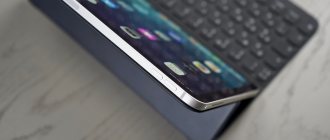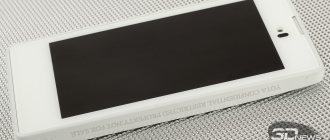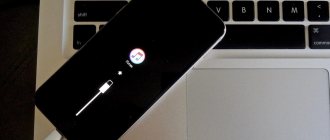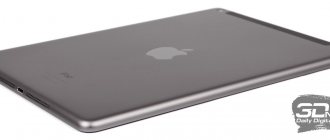Modern iPads are loved for the convenient consumption of visual content on a relatively large screen, for the few truly high-quality mobile games, and for interesting applications for children and their parents. But all the use cases described above can be implemented using a smartphone or laptop - which is why many do not understand why they need another device that duplicates their capabilities. However, Apple continues to sell its branded tablets and does so quite successfully. Here it is - an excellent occasion to remember how the iPad line appeared and developed.
Subscribe to our Zen
Subscribe to our Zen
iPad 1
The first iPad went on sale in 2010 and became a truly revolutionary gadget that received many technologies that other tablet PCs did not have at that time - an IPS display and a powerful gigahertz Apple A4 processor.
High operating speed, a screen with a diagonal of almost 10 inches and a capacious 6667 mAh battery made the iPad 1 popular.
However, it was still just an experimental model, with a number of shortcomings and shortcomings.
Among the disadvantages of the device were the relatively short operation time on a single charge - even such a battery was not enough for the large display and the resource-intensive iOS operating system.
In addition, the iPad was quite thick by the standards of other tablets and did not come with a camera, which is why it could not be used for video chatting.
But its body has rounded edges and stylish volume control buttons on the right side.
The developers’ original solution was the button for switching lock modes and screen orientation, which lights up green when turned on.
Another impressive characteristic is the tablet’s built-in memory, the maximum capacity of which was 64 GB.
Although the rather modest RAM parameters did not allow installing more modern versions of iOS on the tablet.
Technical specifications:
- Screen size: 9.7 inches;
- resolution: 768 x 1024;
- processor: single-core, 1000 MHz;
- cameras: none;
- memory capacity: 256 MB RAM and from 16 to 64 GB built-in;
- Battery capacity: 6667 mAh.
iPad 1
2010: iPad
Steve Jobs at the presentation of the first iPad | Wired
During the presentation of Apple's first tablet in 2010, Steve Jobs asked those in attendance if there was room for a new category of gadgets somewhere between the iPhone and MacBook. I assume that the majority was ready to answer this question in the negative. However, the iPad, whatever one may say, proved the opposite.
The aluminum body of Apple's first tablet is very tactilely reminiscent of today's iPad Pro. Yes, the current flagship line is noticeably thinner, but the chopped side edges inevitably create associations. The body of the original iPad was made of aluminum; the mobile device was equipped with a 9.7-inch IPS screen, which was surrounded by an impressive black frame. Interestingly, this device did not have a front or rear camera - apparently, Apple had not yet decided why they might be needed.
Original iPad | Elias Makos
The manufacturer's first tablet was equipped with three storage options: 16 GB, 32 GB or 64 GB. It had a fairly powerful Apple A4 chipset for that time, as well as an impressive battery life: as much as 10 hours without connecting to power - fantastic from 2010.
Interesting facts about this iPad model:
- even after the release of the first iPad, iOS had a different name, iPhoneOS - however, after the operating system became truly universal for two categories of gadgets, a more concise and universal name had to be chosen for it;
- For the first iPad, Apple released a special docking station that made it easier to use the tablet with a keyboard or as a photo frame:
iPad 2
The next generation of iPad, which appeared in 2011, was more advanced and had many fewer shortcomings.
First of all, this concerned the amount of RAM that had increased to 512 MB - quite enough to run modern applications and install new operating systems.
In addition, the model received two cameras at once - the main one with 0.69 megapixels. and front with VGA resolution (640 x 480), gyroscope and dual-core processor.
These updates made Apple's tablets even more popular and allowed them to sell a second iPad for four years.
Among other features of the tablet, it is worth noting the possibility of purchasing them in two color options - and although the body still remained silver, the frame on the front panel could be black or white.
And one of the few characteristics remaining from the previous model were the size and resolution of the screen (however, quite modern for 2011–2012), and built-in memory of 16–64 GB.
Device parameters:
- device display: diagonal 9.7", resolution 768x1024;
- RAM: 0.512 GB;
- built-in memory: 16, 32 and 64 GB;
- chipset: 2 cores, 890 MHz;
- camera parameters: 0.69 and 0.3 megapixels;
- battery: 6930 mAh.
iPad 2.
iPad 3
In 2012, the next generation of iPad went on sale, as usual, surprising fans of the Apple brand with new characteristics.
Especially with increased screen clarity, an exceptionally powerful battery and a decent camera, more suitable for a good smartphone than a tablet PC.
It was by the size of the lens on the cover that one could distinguish the third generation of iPad from the second - there were practically no other design changes.
If we consider the technical parameters of the device, among the innovations we can note the increased strength of the display protected by Retina glass.
And models that support the installation of a SIM card were no longer equipped with a 3G module, but with 4G technology.
Although at this time this more modern connection could only be used in a few countries, and for most users the feature was practically useless.
Main characteristics:
- tablet screen: 9.7 inches, 1536x2048 pixels;
- processor: dual-core, 890 MHz;
- battery: 11560 mAh;
- cameras: 5 megapixels. main, 0.3 megapixel. for selfies;
- memory: 16, 32 and 64 GB built-in and 1 GB of RAM.
iPad 3.
Classic line
The first iPad was shown in 2010. A revolutionary product at that time, now it looks clumsy. The weight of the gadget exceeded half a kilogram, and the technical parameters left much to be desired. The first iPad did not have a camera .
- Display 9.7 inches with a resolution of 1024 by 768.
- The storage size is 16, 32 or 64 GB.
- CPU: Single core A4 processor.
In 2011, the situation did not change radically. The iPad 2 looked awkward. Although the body was made more streamlined. But the technical characteristics have improved noticeably. The second iPad even had a camera.
- CPU : A5.
- RAM : 512 MB.
- Front camera 0.7 MP.
- Rear camera 0.3 PM.
In 2012, the third revision of tablets created a real sensation. The design began to resemble the modern look of devices, and the technical parameters of iPad 3 took several steps forward:
- Innovative display measuring 1536x2048.
- Storage capacity - 16, 32 or 64 GB
- First acquaintance with Siri .
- CPU : A5X.
- RAM 1 GB.
Ways to flash or restore iPhone yourself
In 2012, another event happened - the iPad 4 was released. In fact, the public was presented with a modified version of the “troika”, from which it is practically no different except for a few points:
- Improved Lightning connector.
- Implementation of all three representatives of WiFi.
- The maximum memory capacity has been increased to 128 GB.
The classic line of tablets was in a lull until 2017, when the company demonstrated the iPad 5. The distinctive features of the model are support for the latest OS versions, an updated processor and increased battery capacity. More details about technical specifications:
- Added Touch ID .
- Modern A9 processor
- 2 GB RAM
- Screen 9.7 inches with a resolution of 1536 by 2048.
iPad 4
In the fall of 2012, Apple presented two new tablets to potential buyers, one of which was the fourth generation iPad.
Visually, it differed little from its predecessor, but at the bottom it had a modern connector for a charger and connection to a Lightning computer.
The difference from the previous version of the port was a more compact design and the ability to insert the cable from either side.
Among the improvements to the Tablet PC are a powerful A6X processor, an updated graphics core and a 1.2-megapixel front camera.
In addition, the model came not only with the standard memory capacity of 16–64 GB. Already at the beginning of 2013, devices with 128 gigabytes appeared on sale.
Equipment parameters:
- display diagonal: 9.7";
- resolution: 1536x2048 pixels;
- processor: 2 cores, 1400 MHz;
- tablet cameras: 5 megapixel/1.2 megapixel;
- memory: RAM – 1 GB, ROM – 16, 32, 64 and 128 GB;
- battery: 11560 mAh.
iPad 4.
New iPad release date
According to analysts, there is no point in expecting a new version of the iPad in the coming year. The presentation of the iPad 6 took place just recently, so the issue of the new product is postponed until next year. Among the new products this year, we can only expect new versions of the OS, as well as the availability of the AirPower charging station. In addition, the company has not yet officially announced the iPhone SE 2.
iPad mini
The first generation of smaller Apple tablets hit the market at the same time as the iPad 4.
In terms of technical parameters, the iPad mini was an almost complete copy of the iPad 2, but it already had a Lightning port, a more modern selfie camera, and a 4G module.
Disadvantages include the screen resolution (only HD) and a not very powerful battery.
However, taking into account the relatively small size of the gadget, these parameters were enough for 8–10 hours of work and obtaining good picture quality.
To reduce its size, the model received trimmed frames along the edges of the screen. Moreover, the entire body of the tablet was made in the same color.
And the volume control buttons were made as separate keys for the first time.
Model features:
- Screen parameters: 7.9 inches, 768x1024;
- device memory: 512 MB/16–64 GB;
- chipset: 2 cores, 890 MHz;
- maximum camera resolution: 5 megapixels. and 1.2 megapixels;
- Battery: 4400 mAh.
iPad mini
Apple ABC. Part 4: The history of the iPad - how it all began
In 2010, Apple was the largest supplier of mobile technology. The company is ahead of such manufacturers as Samsung, Nokia, Blackberry, Sony. At that time, Apple produced iPod, iPhone, MacBook. Many people used phones, players, laptops every day. What prompted Apple to create the iPad tablet computer? How did the iPad change the direction of the mobile industry?
Steve Jobs placed a MacBook and iPhone next to each other. The thought struck him that there must be something in between connecting these two devices. At the time, many companies were making netbooks that were smaller than laptops, but Jobs said they were just cheap laptops. An “intermediate” device should contain the functions of a laptop and a smartphone, it should be better than a phone and better than a laptop, that is, combine the following functions: viewing websites, photos, videos, reading books and supporting games; be simpler, lighter and more convenient than a laptop. So, in 2010, Apple presented the first generation iPad, which perfectly combined the above functions. People really needed such a device.
History of the first generation iPad
The first iPad was designed by Jonathan Ive. Apple's design philosophy is very complex: there is nothing superfluous on the devices and, at the same time, there is everything that the user needs. Steve Jobs believed that a person holding an iPad should have full control over the tablet, only then he could enjoy working on the iPad. The concept of controlling the device was taken from the iPhone, that is, the iPad had a built-in accelerometer and light sensors. The tablet body is made of aluminum, and the Apple logo made of glass is located on the back panel in the center. The front of the iPad is covered with solid glass, with the Home button located at the bottom center; on the left side panel there is a sound mode switch and volume control; On the top side panel on the left is a headphone input (3.5 mm), and on the right is the power button. The iPad screen diagonal was 9.7 inches. Display resolution: 1024×768 px. The thickness of the device is 1.25 cm, weight is 670 g (without GSM module) and 680 g (with GSM module). iPad 1G was released only in black. Apple's calling card is that the iPad can work for 10 hours without interruption. These 10 hours were subsequently maintained with the release of more powerful products. The iPad also had a built-in accelerometer, which in most cases is used to control games, and light sensors that adjust the brightness of the iPad depending on the room lighting. Apple released the first iPad 16 GB, 32 GB and 64 GB versions. The company had to develop its own processor, called the A4, which was responsible for graphics and task execution. The price for iPad 1G started at $499.
Thus, by creating the iPad, Apple made a successful start in the tablet market. Of course, many manufacturers tried to produce their own iPad to compete, but in the end, no one managed to do better. Soon the Apple tablet began to be used in education, medicine, and business.
History of the iPad 2
As we stated above, the iPad turned out to be a great product that people wanted. So, Apple decided to improve it by changing the design and hardware. In 2011, the iPad 2 appeared on the tablet market. The thickness of the iPad 2 turned out to be 1/3 thinner than its predecessor. The rear panel has been redesigned with rounded corners on the side panel. Holding the iPad has become more comfortable. All buttons were left in place. The main difference between the iPad 2 and the first generation iPad was the presence of front and rear cameras. iPad 2 was released in black and white colors. The design was taken as the basis for the development of The new iPad (third generation iPad) and iPad 4. The iPad 2 was equipped with a dual-core A5 processor, where the first processor was responsible for graphics, the second for performing tasks. Thus, Apple managed to make the iPad 2 faster than the first generation iPad. Despite the hardware improvements, power consumption remains the same - 10 hours. As we mentioned above, the device's 10 hours of battery life is Apple's calling card. The display resolution remains unchanged, as does the diagonal - 1024 x 768 px, 9.7 inches. The front camera was installed above the screen in the middle, the quality of which was 0.3 MP. The rear camera quality is 5 MP.
Apple brought the first tablet to life by creating the iPad 2. This tablet is still used by many people, despite the fact that 4 years have passed since its creation. We remember the iPad 2 for its changed design and the presence of two cameras.
The emergence of The New iPad (iPad 3)
Following the iPad 2 came the iPad 3 or, as it is also called, The New iPad. The design remains the same, except that the thickness has become a little larger due to the battery. The main change affected the display: the iPad 3 was equipped with a Retina display, the resolution of which was 2048 x 1536 px, that is, Apple increased the pixel density, making the image much better quality. The New iPad has a built-in A5X processor, in which 2 processors provide computing processes and 4 provide the graphics part. Changes also affected the rear camera: users were able to shoot video in 1080 px quality. iPad 3 came in two colors - black and white. The back panel of iPads (up to iPad 4th generation) is silver. We remember The New iPad for its Retina display, more powerful processor and high-quality camera.
History of the iPad 4
iPad 4 (with Retina Display) came out 8 months after the release of iPad 3. It was obvious that we shouldn’t expect any major changes, so let’s talk about updates right away. The connector for the Lightning connector has been changed due to changes in the Lightning cable itself.
The iPad 4 was equipped with an A6X processor, thanks to which the system runs even faster. The front camera was also improved: users were allowed to shoot video in 720 px quality. The rest remained the same: screen resolution - 2048 x 1536 px, diagonal - 9.7 inches, camera - 5 MP, available in black and white, in 16 GB, 32 GB, 64 GB, 128 GB versions. By the way, starting with the iPad 4, Apple began releasing a 128 GB version.
iPad 4 with Retina Display is a polished iPad 3. Many users of Apple technology did not know what to do: “Should I change my iPad 3 to iPad 4?” If you compare these models, the answer comes by itself. However, iPad 2 owners should still buy an iPad 4.
iPad mini history
The Android tablet market does not stand still. By 2013, there were many tablets on the market: with a wide range of display diagonals, models, with a variety of memory, etc. Small devices have become increasingly popular among tablets. So, Apple decided to occupy this niche by developing the iPad mini. The release of the iPad mini was rather a response to small tablets. However, the iPad mini began to gain popularity.
The design of the iPad mini has been changed. The corners on the back panel have become sharper (almost straight). The shape of the iPad mini resembles an expanded iPod Touch 5. Apple decided to release the iPad in two colors: black and white. The back panel also now has its own color. The side bezel has been reduced in size, giving the iPad a more rectangular appearance. Apparently, this was done for the convenience of holding it in one hand and to emphasize its mobility. The display diagonal is 7.9 inches, screen resolution is 1024x768 px, pixel density is 163, weight is 308 g (without 3G module), 312 g. - the rest, thickness - 7.2 mm.
At first, Apple was criticized for the fact that it had lost the zest of modern tablets, that under Steve Jobs this would not have happened and the like, but over time the iPad mini began to be purchased in large volumes, which proves the usefulness of this device. The iPad mini can be compared with the iPad 2, since apart from the screen resolution, the characteristics of these devices are almost the same, which affects good performance.
iPad Air - a new breakthrough
In the fall of 2013, the iPad Air . After 3 years, Apple decided to change the design of the device. The body is made of aluminum, the design of the frames was taken from the iPad mini. We can say that the iPad Air is an iPad mini enlarged to standard sizes. The display diagonal remains the same - 9.7 inches. Screen resolution - 2048 x 1536 px. The pixel density per inch is 264. Every time Apple has to think about maximizing the convenience of the device. The iPad is becoming thinner, smaller, and thus more convenient, but this may negatively affect the performance and operating time of the tablet. Apple successfully combines the shape, design and performance of the iPad. The thickness of the iPad Air is only 7.5 mm; due to the reduction in battery size, the weight of the iPad has become significantly less - 469 g. The operating time of the device is also 10 hours. The tablet is equipped with a new dual-core A7 processor and for the first time on the iPad Air, a co-processor for processing motion data has appeared - the Apple M7. The rear camera quality is 5 MP. iPad Air comes in two colors: black and white, the back panel also has black and white colors. Memory size: 16 GB, 32 GB, 64 GB, 128 GB.
As we see, Apple produces tablets that are similar in characteristics to PCs. In general, there are no global changes in tablets, except for increased productivity, since people are satisfied with what they have. iPad satisfies people's needs.
The appearance of iPad mini 2 on the tablet market
After the release of the iPad, many said that Apple was violating the main covenants of Steve Jobs, but then, as it turned out, people needed an eight-inch tablet. iPad mini users were not very happy with the screen resolution. With the release of the iPad mini 2, things changed radically. The thickness of the iPad mini 2 is 7.5 mm. Instead of black, the iPad began to be produced with a grayish tint (space grey) known to everyone from the iPhone 5s; the white color was retained. The main change in the iPad mini 2 was the increase in screen resolution to Retina - 2048 x 1536 px, pixel density per inch is 326 ppi. The tablet has an A7 processor with an M7 coprocessor.
Apple brings their projects to perfection, trying to pay attention to important subtleties, and they do it quite well. The main thing we remember about the iPad mini 2 is its Retina display.
History of the iPad Air 2 tablet
The iPhone 5s debuted a Touch ID fingerprint scanner, which is needed to make purchases in the App Store, iTunes Store and to unlock the device. It wasn't hard to guess that Apple would implement Touch ID in the iPad.
On October 16, 2014, there was a presentation of the iPad Air 2 and iPad mini 3, which included a fingerprint scanner. The iPad Air 2 isn't all that different from the iPad Air, but it's all the little changes that make the new iPad a unique device. Surprisingly, the iPad Air 2 is 6.1mm thick, while the iPhone 6 is 6.9mm. Weight - 437 g (without 3G module) and 444 g (with 3G module). Screen resolution: 2048×1536 px, 264 ppi. Apple has decided to remove the 32 GB version; only 16 GB, 64 GB and 128 GB versions are available for sale. The Lightning connector remains the same. The iPad Air 2 no longer has a sound mode switch. This was done to make the iPad as thin as possible. The iPad Air seemed like the ideal tablet, but Apple has created something even better. iPad Air 2 is equipped with a triple-core A8X processor and two gigabytes of RAM, which enhances multitasking and productivity of the device. The changes also affected the rear camera - 8 MP. The tablet is produced in three colors: space gray (front side is black, back side is gray), silver (front panel is white, back panel is silver) and gold (golden back panel, front panel is white).
iPad mini 3 history
The iPad mini 3, which was presented along with the iPad Air 2, is also equipped with a fingerprint scanner. At the presentation, Apple spent little time on the new iPad mini 3, since there were no major changes. The iPad has been added to Apple's line of mini-tablets, with a gold-colored back panel. The display and camera remain unchanged. If you look closely, you can see that there is no ring in the rear chamber. The most important change was the appearance of a Touch ID scanner covered with sapphire crystal. iPad mini 3 is available in 16 GB, 64 GB and 128 GB versions.
Thus, at the moment the iPad is the most optimal device on the tablet market. Apple sets the trend, other manufacturers are trying to achieve that perfection. As proof that the iPad is the best tablet solution, Apple's share of the tablet market is around 30%. We hope that in the future Apple will also delight us with its developments, and other devices will only get better.
iPad Air
In 2013, Apple released a tablet model that combines both a large screen and compact dimensions.
It was called Air and looked like an enlarged copy of the iPad mini.
Due to the reduced frame thickness, the dimensions were noticeably smaller compared to the fourth generation iPad, although the display diagonal was the same.
The innovations of the gadget include the stereo speakers that have appeared at the bottom, and the ability to support regional mobile communication bands LTE and 3G.
Equipment characteristics:
- display: 9.7";
- resolution: 1536x2048;
- memory: 1 GB/16–128 GB;
- cameras: 5 and 1.2 megapixels;
- processor: dual-core, 1300 MHz;
- battery capacity: 8850 mAh.
iPad Air.
How to find out your iPad model
If you want to buy a device from Apple, then you need to know everything about the tablet model. This kind of knowledge is especially good when you buy a tablet from someone else. Each iPad is well-built, but the hardware can vary greatly. Without knowing all the intricacies, there is a possibility of overpaying for an obsolete device. Although there have been cases when unscrupulous online stores sent customers an Iphone 5 instead of an Iphone SE. In order to avoid such troubles, we offer several steps to help you decide:
- Carefully study the variations of one model. Each tablet is sold in several variations. Typically, the differences lie in the ability to support cellular communications. To know in advance which device supports a SIM card, you need to know the model number. That is why identical tablets can have different numbers.
- Inspect back devices. The serial number is written at the bottom of the case: look for the word “Model” on the case. Write down the numbers on a piece of paper and check with the official information.
If you have the iPad in your hands and the desire to find out information about it is a personal interest, then you can use the iTunes service .
After synchronization, the service will instantly display detailed technical characteristics of the device on the screen.
iPad mini 2
The second generation of the mini version of the iPad looked practically no different from the first. However, even when turned on, one could notice the improved resolution of the screen protected by Retina glass.
In addition, the new iPad has increased battery capacity, allowing you to get several more hours of work.
And the top version was equipped with 64 GB of memory, and twice as much memory - like a real “adult” iPad.
Characteristics:
- screen: 7.9", 1536x2048;
- processor: 2 cores, 890 MHz;
- device cameras: 5 megapixels. main, 1.2 megapixels. - for selfies;
- RAM: 1 GB;
- built-in memory: 16, 32, 64 and 128 GB;
- Battery capacity: 6471 mAh.
iPad mini 2.
iPad Air 2
In October 2014, the iPad lineup was replenished with a new gadget - the next generation Air, distinguished by the presence of a fingerprint sensor, a thinner body, an A8 processor and 2 GB of RAM.
The same tablet was equipped with 3 GB of RAM and was available in three colors - silver, gray and gold.
The capabilities of shooting using the gadget have also increased - the front camera has a resolution of 8 megapixels.
Main parameters:
- tablet display: 9.7 inches, 1536x2048 pixels;
- memory: 3 GB RAM, 16–128 GB built-in;
- processor: triple-core, 1.5 GHz;
- cameras: 8 and 1.2 megapixels;
- battery: 7340 mAh.
iPad Air 2.
iPad mini 3
The popularity of compact versions of the iPad led to the emergence of the third generation mini just a year after the release of the second.
Among the changes were the presence of a golden color in the line of models and the absence of an option with 32 GB of RAM.
Most other characteristics, except for a more powerful processor, remained at the same level. Visually, the gadget was distinguished by the edging of the Home button, which matched the color of the body.
Tablet parameters:
- screen: 1536x2048 pixels, 7.9 inches;
- chipset: 2 cores, 1300 MHz;
- cameras: 5 and 1.2 megapixels;
- memory: RAM – 1 GB, ROM – 16, 64 and 128 GB;
- Battery capacity: 6471 mAh.
iPad mini 3.
2018: iPad 6th generation, iPad Pro 11″, iPad Pro 12.9″ 3rd generation
iPad 6th generation | iMore
The base 6th generation iPad wasn't particularly different from its predecessor. Its main innovation was the use of the Apple A10 Fusion chipset, originally from the iPhone 7. It works more than perfectly even in 2022 - I can confirm this fact with my own experience.
iPad Pro 11 inches | TechRadar
In 2018, Apple rethought the design of the iPad Pro. The company began using chopped edges and minimal body thickness - this year Apple did the same with flagship tablets as it did with smartphones in 2020. Moreover, she added a Face ID facial scanner to these gadgets and replaced Lightning with USB-C.
iPad Pro 12.9-inch 3rd generation | iMore
The heart of the tablets turned out to be the truly powerful Apple A12X Bionic chipset. Among other things, they also received support for the 2nd generation Apple Pencil, which acquired a magnetic design - it made it possible to keep it “fastened” to one of the edges of the tablet.
Interesting facts about these iPad models:
- in 2022, the iPad Pro line for the first time acquired the ability to install a 1 TB drive - this value remains amazing for the current mobile device market;
- The main misunderstanding of the iPad Pro this year was the insufficiently durable case, which was relatively easy to bend in half - sometimes it became deformed when carried.
iPad Pro 12.9
The next iPad, which they decided to name not by generation number (but, in fact, it was already the fifth iPad), received a 12.9-inch screen with a resolution of 2732 x 2048 pixels - the maximum for all Apple tablets and for any analogues of other brands.
There are now 4 speakers on the body, providing true stereo sound.
And on the left side there is a special port for connecting an external keyboard - after all, the diagonal display of the iPad Pro 12.9 is enough for it to work as a small laptop.
Other improved characteristics include 4 GB of RAM and a 2.26 GHz processor, comparable to conventional computers.
In addition, users were able to use the Pencil stylus and a mode for simultaneously running two applications on the screen.
Before this, no tablet had such capabilities.
Gadget features:
- display: 12.9 inches, 2048x2732 pixels;
- memory: 4 GB of RAM and 32, 128 or 256 GB built-in;
- processor: 2 cores, 2260 MHz;
- cameras: 8 and 1.2 megapixels;
- Battery capacity: 10307 mAh.
iPad Pro 12.9.
2017: iPad 5th generation, iPad Pro 10.5″, iPad Pro 12.9″ 2nd generation
iPad 5th generation | iMore
In 2022, Apple unexpectedly returned its line of basic tablets to the market - it launched the 5th generation iPad, which was notable for its affordability. It was a slightly thicker copy of the 2nd generation iPad Air, with an air gap under the screen and powered by the Apple A9 chipset (from the iPhone 6s).
iPad Pro 10.5 inches | Engadget
In 2022, Apple decided to divide its tablet lines by screen size. To achieve this, the company launched a 10.5-inch iPad Pro model, which replaced the 9.7-inch one. The heart of the gadget was the Apple A10X Fusion chipset, which turned out to be up to 30% more productive than the Apple A9.
iPad Pro 12.9-inch 2nd generation | iMore
The 12.9-inch iPad Pro 2nd generation was only a logical evolutionary continuation of the previous model. It retained exactly the same display, the same appearance and other parameters, but received a more recent chipset. Switching to it from its predecessor was, at least, not particularly logical.
Interesting facts about these iPad models:
- Few remember that it was in 2022 that Apple equipped the Pro line with ProMotion technology, which increases the screen refresh rate to 120 Hz - a fantastic new experience that is not available on the iPhone even in 2022.
iPad mini 4
The appearance of the new iPad mini brought updates in both design and technical specifications.
First of all, this affected the thickness of the gadget, which decreased to 6.1 mm and led to a loss of compatibility with older iPad accessories.
The lever for switching orientation modes disappeared from the body, but the amount of RAM doubled, and the front camera became 8-megapixel.
The iPad's battery capacity has decreased, but due to reduced power consumption, it can be used for the same 10 hours.
And the new PowerVR GX6450 graphics processor allows you to not only run high-resolution video on the tablet, but also play modern games for several more years.
Device characteristics:
- screen: 7.9", 1536x2048;
- processor: dual-core, 1500 MHz;
- RAM: 2 GB;
- camera resolution: 8 and 1.2 megapixels;
- built-in memory: 16, 32, 64 and 128 GB;
- battery: 5124 mAh.
iPad mini 4.
2012: iPad 3rd generation and iPad 4th generation, iPad mini
iPad 4th generation | iMore
As with smartphones, things haven't always been smooth sailing for Apple's tablets. A striking example is the 3rd generation iPad, which the company launched at the beginning of 2012. Its main innovation was twice the resolution in height and width - four times more pixels on the screen and the name Retina. The company wanted to ensure that individual dots on the gadget’s display were not visible, and it did this - 264 PPI, taking into account the average distance to the eyes during use, was more than enough. However, the gadget received the Apple A5x chipset - it was ahead of its predecessor, but still could not cope with the increased load by 100%.
It was because of insufficient performance that the company launched the 4th generation iPad in the second half of the same year. In addition to the up to two times faster chipset, Apple A6x, the new product also received a Lightning port, to which a large-scale transition began, including in the iPhone.
The first iPad mini | iPad Insight
In the same year, Apple launched a new tablet format - the 7.9-inch iPad mini. It received the screen resolution and chipset from the 2nd generation iPad - in fact, it became its hardware copy in a smaller body. It had more than enough performance at the time, and many people really liked its size.
Interesting facts about these iPad models:
- The 3rd generation iPad is very similar to the iPhone X in some ways - both devices were on sale for less than a year;
- At the time of the release of the 3rd generation iPad, the App Store already had more than 200 thousand applications tailored specifically for the device’s large screen.
iPad Pro 9.7
The success of the larger and improved iPad Pro led to the emergence of a new model - with a regular screen, but the same serious characteristics.
The top version of the device received 256 GB of RAM, an IPS matrix with improved color reproduction and a dual-core processor with a frequency of 2.16 GHz.
In addition, the screen of the new model supports the technology of simultaneously running two programs, working with Apple’s proprietary stylus, and changing the color scheme depending on the lighting.
And on the case there are 4 stereo speakers and the same connector for the keyboard.
Model features:
- tablet processor: 2 cores, 2.16 GHz;
- memory: 2 GB RAM and from 32 to 256 GB built-in;
- screen: 9.7", 1536x2048;
- camera parameters: 12.0 and 5.0 megapixels;
- battery: 7306 mAh.
iPad Pro 9.7".
iPad 5
The latest iPad model to date can be called the seventh generation of the tablet.
Although, due to the numbering that changed as a result of the release of the Pro and Air versions, it is called iPad 5, there are no special innovations in this version - users were not impressed by the gadget’s battery, nor the standard screen, nor 2 GB of memory.
And the only external difference from the Air models is the absence of hardware volume changes - now you can increase or decrease it only on the tablet display.
The advantages of the gadget include increased processor power by 60% and almost doubling the performance of the graphics chipset.
Another plus is the most affordable price in the entire history of the series. The basic version of the model can be purchased for only $329.
Main characteristics:
- display: 9.7 inches, 1536x2048;
- memory: 2 GB/32 and 128 GB;
- battery: 8827 mAh;
- processor: dual-core, 1800 MHz.
iPad 5.
conclusions
A review of all iPad models shows that Apple continues to improve its tablets even more efficiently and faster than its line of smartphones.
At the same time, decent capabilities and quite affordable prices allow the gadgets to compete well with the top versions of other manufacturers.
And not only among fans of Apple products, but also among users who prefer high performance and modern technologies.











